Fever in cats – Causes and symptoms
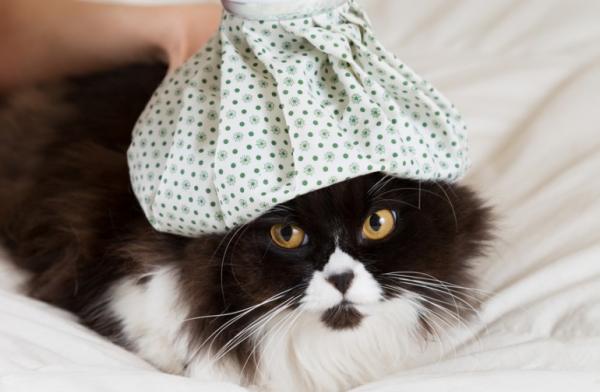
La normal body temperature of a cat it must oscillate between the 38 and 39.5ºC, when it is exceeded it is considered that the feline has a fever and, therefore, his health is being impaired. Regardless of the cause that causes it, fever is always a sign that the animal is suffering from some type of disease or health problem, so identifying it as soon as possible is essential to detect the focus and start the best treatment quickly.
Keep in mind that the causes can range from mild problems to diseases of a more serious nature that can even end the life of your cat. That is why knowing how to recognize the symptoms and take the cat to the veterinarian is of vital importance. To help you, in this article we tell you all about fever in cats, the causes, symptoms, treatment and prevention.
What are the causes of fever?
In general, both in dogs and cats, fever occurs when the animal’s immune system is activated due to the presence of a specific abnormality in the body. Since not all health problems cause it, below we show you the most common causes that usually develop fever in the cat:
- Tumors, which tend to affect older cats more than young ones
- Viral or bacterial diseases, such as distemper or leukemia
- Viral, bacterial or fungal infections of a milder nature
- Flu and common cold
- Pancreatitis
- Lupus
- Medication intake as a side effect
Although these are the most common reasons that tend to develop fever, keep in mind that this is not the only symptom they present, so it is essential that you pay attention to the general behavior of your cat for identify the cause and start the best treatment. Especially if it is a tumor, distemper or leukemia, you must act quickly; These diseases have a very high mortality rate.
Symptoms of fever in cats
To answer one of the most frequent questions of cat owners, How to know if a cat has a fever, it is essential to pay attention to all the details of their behavior. A cat with a fever will have several or all of the following symptoms:
- Dry nose. Although this fact can not be conclusive or definitive, it can give us a clue if we observe that our cat has other symptoms besides this one. Like dogs, cats usually have a wet nose at all times, when they develop a fever, tends to dry out.
- Loss of appetite. The general poor condition that his body is experiencing leads him to not want to eat as usual.
- Decrease in water consumption. Cats are not usually animals that tend to drink large amounts of water, so reducing them can have serious consequences.
- Apathy, lack of energy. Especially if your cat is a very moving and energetic animal, seeing it without wanting to play, run or jump is a clear indication that something is happening to him.
- On the contrary and depending on the disease that causes the fever, the cat can show restless and distressed.
- Lack of personal hygiene. Cats are extremely neat animals, neglecting their cleanliness is not their own and indicates that their health is not in perfect condition.
- In the most serious cases, the cat may suffer shaking chills, tremors or a accelerated breathing.
Most diseases or health problems that cause fever in the feline, often develop other symptoms such as diarrhea, vomiting, sneezing or coughing.
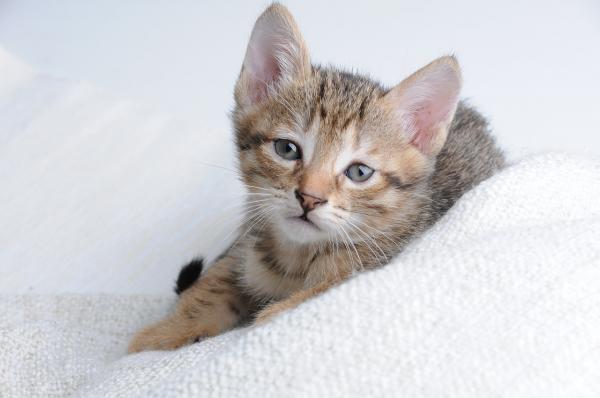
How to take my cat’s temperature?
If we observe that our cat has some or all of the above symptoms, the time has come to take your body temperature, because this is the only way to confirm that you really have a fever. To do this, you must get all the necessary utensils:
- Digital rectal thermometer that you can get at any veterinary clinic.
- Vaseline, or any other lubricant.
- A clean cloth or towel.
When you have everything ready, follow these steps to take your cat’s temperature:
- Clean the thermometer well and cover the tip with a little petroleum jelly or other lubricant.
- If you can, tell another person to hold the cat in the area of the front legs, so it will be easier for you to continue.
- Carefully lift the tail of your cat and insert the tip of the thermometer in its rectum.
- When you notice that the digital thermometer stops, remove it, observe the indicated temperature and reward your pet for good behavior. Clean the thermometer.
As we commented at the beginning, the normal temperature should oscillate between the 38 and the 39ºC, in adult cats, and the 39.5ºC in puppies. If your cat exceeds these figures, we consider that you have a fever and you will have to treat it to reduce it as soon as possible. In case of exceeding 41ºC you should go to the vet quickly for him to examine it and determine the cause.
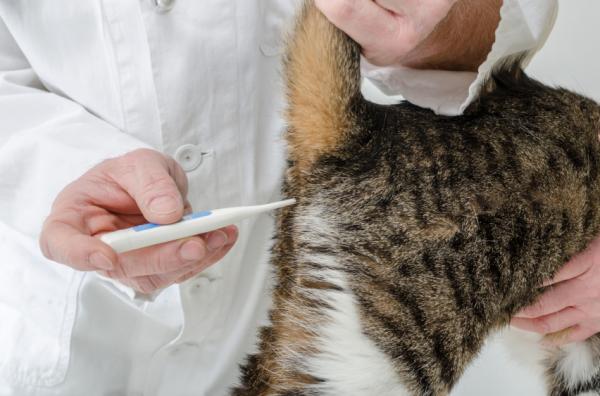
Measures to lower my cat’s fever
The treatment for fever in cats goes closely linked to the cause that causes it. If, for example, it appears as a secondary effect to the consumption of a certain medicine, you should consult with the veterinarian what to do, but never decide for yourself to interrupt a medical treatment. If the cause is a serious illness, such as distemper, leukemia or cancer, the specialist will initiate the best treatment to eradicate this pathology. For minor bacterial or viral infections, the veterinarian may prescribe an antibiotic. Remember that you should not self-medicate your cat, some medications for human consumption are toxic to him and you will only get worse his condition.
In the mildest cases, such as a common cold, you can take some measures and home remedies to reduce the fever of your feline:
- As one of the symptoms of fever is the decrease in water, the first thing you should do is hydrate your cat. If you do not want to drink, you should get a syringe and give yourself the amount of fluid you need, always carefully and slowly, we do not want you to drown! The water must be fresh.
- The same thing happens with feeding. To avoid malnutrition, you must encourage your cat to eat by providing food that meets their nutritional needs and, at the same time, is palatable. To do this, opt for a wet diet, once recovered you can combine it again with dry feed. Of course, if the fever is accompanied by vomiting or diarrhea, it is best to check with the veterinarian what diet to provide.
- Find a place in your home free of moisture and warm to place your bed there. Your cat should feel as comfortable as possible to promote his recovery.
- The wet compresses They will be your great allies to reduce your cat’s fever. You will have to moisten them with cold water, place them on your forehead and let them act for a few minutes. Then, remove them and apply them on their legs and abdomen area and English in the same way. Dry the wet areas well and repeat this process twice a day.
If after the 48 hours the fever does not subside, you must go to the vet quickly. It is possible that you have not noticed other symptoms and are developing a serious disease that requires medical treatment. Remember that you should always be a specialist to examine your pet, diagnose the cause and prescribe the best treatment.
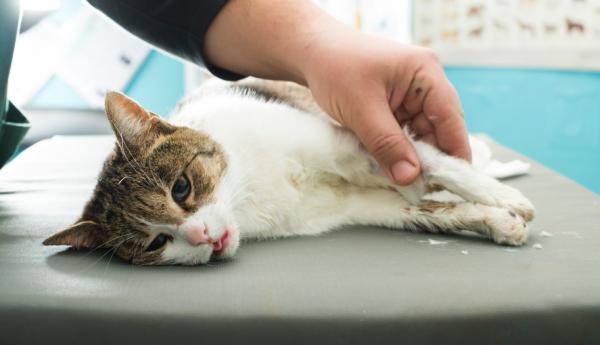
Prevention, the best treatment
As we have seen throughout the article, fever is a symptom of another pathology that can be severe or mild. Therefore, the best treatment is always prevention. To prevent the onset of diseases, infections and other health problems, it is essential follow the mandatory immunization schedule, make routine visits to the veterinarian and provide our cat with all the basic care he needs, such as proper nutrition, toys to release the accumulated energy, scrapers, brush his coat to avoid the creation of hairballs, a comfortable bed for sleep and a litter box to relieve yourself.
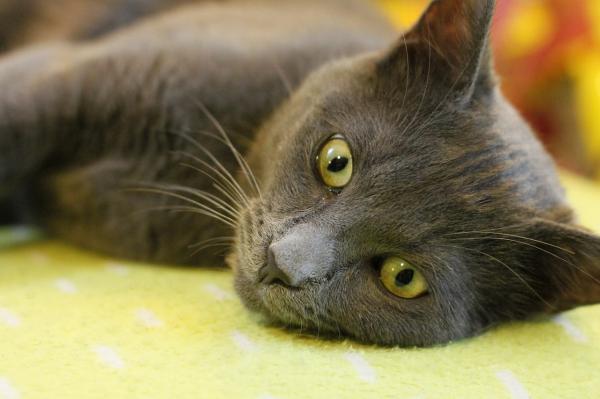
This article is merely informative, in .com we do not have the faculty to prescribe veterinary treatments or make any kind of diagnosis. We invite you to take your pet to the veterinarian in case of any type of condition or discomfort.
If you want to read more articles similar to Fever in cats – Causes and symptoms, we recommend that you enter in our section of Infectious diseases.


